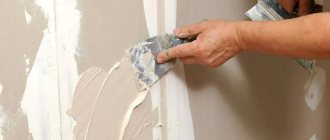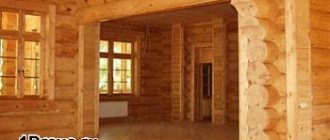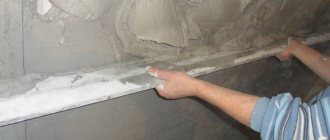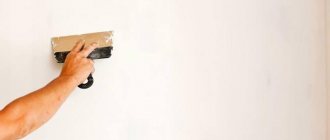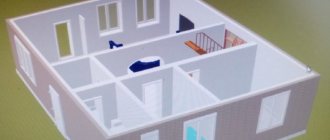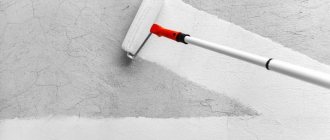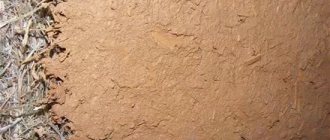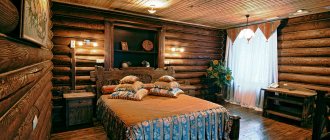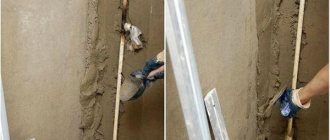Putty on clay, is it possible to putty on clay walls with gypsum putty?
Putting clay walls indoors is not much more difficult than putting putty on regular plaster, but there are some rules and features that should not be ignored. On several real objects, clay walls were puttied with ordinary gypsum starting and finishing putty, using nylon facade mesh.
The putty adheres well to the clay and holds quite firmly under the wallpaper. But painting walls puttied over clay is a risky business, as an unpleasant crack may appear in a visible place. If you want to paint such walls, we recommend gluing paintable wallpaper or non-woven fabric. Small cracks are not a problem for papered walls; unlike paper wallpaper, non-woven wallpaper is very strong and will never tear due to small cracks.
Advantages and disadvantages of introducing clay
Clay has been one of the main building materials for many centuries ago. At the moment, its use in construction work is not so relevant. But the positive properties of this material demonstrate that its implementation is justified in almost everything.
1. Clay is a material of natural origin. Its natural deposits are huge, and getting to them with your own hands, without resorting to the services of expensive equipment, is completely possible. In addition to clay, you will also need sand and sawdust. But these materials are also inexpensive and available.
2. Clay does not cause reactions in allergy sufferers.
3. Walls plastered with a clay-sand substance amazingly absorb water vapor and odors, thereby maintaining a better level of humidity in the room and promoting natural air filtration.
4. This natural material, combined with environmental friendliness, has good thermal insulation qualities. In a house where the main component of the walls is clay, it is not hot in the summer, but comfortable and warm in the winter.
5. To finish clay walls, ordinary gypsum putty can be used. Later you can glue wallpaper and paint in the same way as on walls made of other materials.
Clay walls also have some disadvantages:
- Being a material that strongly absorbs water, clay requires a special approach to waterproofing. Otherwise, condensation, leaking pipes or roofs, high groundwater levels and other sources of dampness will kill the clay wall, no matter what it is covered with.
- The clay itself is a loose and free-flowing base. When working with it, you should adhere to certain rules and not force it to dry for a long time. All this significantly increases the time required to complete repair work.
When starting to finish clay walls, you should study the specifics of the work and keep them in mind during the repair process. This article will examine the main issue of finishing clay walls - putty, and provide a detailed summary of puttying clay walls. But before you start, you need to go through a preliminary step.
How to prepare clay.
The lumps are crushed, sifted through a coarse sieve, and filled with water for 1-2 days. To speed up the soaking process, the trough can be placed in the sun and covered with film so that the mixture warms up but does not dehydrate. The viscosity of hot water is lower; it penetrates better into rock particles.
Obtaining fine clay.
The quality of clay (including moisture holding capacity) depends on dispersion. Therefore, old masters advise preparing clay for future use: it is poured into shafts (not more than a meter in height) and moistened. In winter, as the mass freezes, it swells and becomes loose. This material is more flexible, more pleasant and easier to work with, and produces fewer cracks. This is especially important when creating decorative, glossy clay plaster.
For plastering stoves, it is better to use dispersed clays, ground by hand or by defrosting. The thickness of the finishing of the heating shield should be minimal so that the brick can release heat without hindrance.
What immediate tools and materials are needed?
When starting to repair and decorate clay walls, you will need the following tools:
- Set of spatulas, trowel, trowel. It is better to choose which tool for puttying clay walls is more ergonomic using the trial method. Some people find it more convenient to use spatulas, while others are used to working with a scourer or other equipment.
- Buckets for mixing clay-sand mortar and putty.
- A construction mixer and a shovel will be indispensable when producing large volumes of finishing mixtures.
- Knife for filling cracks and trimming serpyanka.
- A construction stapler can be useful for securing a meter grid to the wall.
- To find out the evenness of surfaces can be a building level and rule, a plumb line and threads.
The materials needed are:
- Putty for clay walls requires a starting and final putty (depending on what kind of coating is planned to be applied at the end of puttying).
- Reinforcement nylon mesh with a small cell. A narrow serpyanka is needed to strengthen cracks, and a meter-long one will be applied over the entire surface of the wall.
- To adjust the walls using a clay-sand mortar, you need one part clay, two or three parts sand, and water. In addition, if desired, you can add a little sawdust or small grass to reinforce the consistency. To increase plasticity and thermal insulation, the forefathers also added horse manure to the clay. The smear came out strong, even, with a small fraction. The composition should brew well and the mixture should resemble thick, homogeneous sour cream. In addition, you can use a mixture of clay, sand and gypsum in a ratio of 1:4:1/4.
Elimination of irregularities and cracks
After the wall has been treated with a primer, the damaged clay plaster is repaired. Seal existing cracks and restore areas from which peeling pieces were removed.
Plastering on clay is done with a clay solution prepared in the following proportions: 1 part clay, 2.5 parts sand, sawdust as a binding material.
The cracks are widened to a depth of 1 cm, the sides are formed at an angle of 45 degrees.
Clay is soaked in water for a day
The clay is soaked in water for a day to make it plastic. Add the dry ingredients, then add water to create a solution with a creamy consistency.
Clay plaster is applied in several ways:
- using mesh - serpyanka as a base for plaster;
- using the same mortar from which the walls are made.
Use a spatula to apply the solution to the damaged area.
Rub the plaster over the clay using movements in all directions: along, across, down, up. Then rub with a grater. When the surface is dry, apply two coats of primer again. For clay, you cannot use plaster solutions made from ingredients other than clay. The cement mortar will not hold, as it does not adhere well to the clay and does not allow the surface to breathe, which leads to the destruction of the lower layer. To learn how to plaster clay walls using mesh, watch this video:
For plastering on mesh, you can use any putty.
Preparing clay walls
First, you need to remove all old coverings. This applies to both whitewashing and various paints and wallpapers. To facilitate the process of removing old coatings, the walls can be wetted. The swollen top layer of clay will be easy to clean.
The technical features of clay wall smears are that this base is relatively soft and free-flowing.
Before you start leveling the walls with putty, check the clay surface for damage. To do this, tap the wall with the handle of a trowel or spatula. A dull sound and slight movement will reveal places where the clay has moved away and may collapse. To prevent the new renovation from having to be redone because a piece of the wall has fallen off, it is better to remove the unsafe area in advance.
If there are cracks in the clay smear, you need to perform the following steps:
- Using a spatula, knife or trowel, clear the edges of the crack at an angle of 40-5 degrees to a depth of at least 1 centimeter.
- Treat with primer and allow to dry thoroughly.
- Using pressing movements, fill the crack with starting putty or a clay-sand mixture.
- Apply the serpyanka so that it completely covers the fault.
- Cover the top with a layer of putty, pressing the mesh into the mixture.
- Leave the corrected areas until completely dry.
Moreover, in this case, while the clay plaster is done at the highest level, the walls are even and smooth, the components of the composition are kept in perfect proportion, it is necessary to prepare the clay walls for applying putty.
The clay base needs to be strengthened. To do this, use a deep penetration primer. Penetrating into the coating to a depth of up to a centimeter, the primer, when dry, perfectly glues the particles of the loose base, preventing them from disintegrating and preventing excess water from passing through. At the same time, priming the clay walls increases the level of adhesion of the base to the next finishing layer, and prevents the formation of mold, since for the most part, priming consistencies include disinfectant additives. It is also necessary to treat with a primer those places that have been cleaned of weak parts. Before applying putty, you need to prime the clay twice, thoroughly drying any layer.
Nuances
Some aspects of repairing clay ceilings are worth mentioning separately. You can start with the fact that the clay on which the putty will be applied is a very absorbent material. Therefore, the consumption of primer and impregnation can be significantly higher than when working with standard coatings. Do not skimp on the primer and process the surfaces several times.
Reinforcing mesh can be used not only in cases with significant defects. It will help to better fix the putty on the plane, so you can use it even when working with minor damage. The mesh will only make the applied coating stronger and will allow you not to worry about the strength of the finish in the future.
Even in cases where a mesh is used, do not apply the first composition too thickly. The main thing is that the mixture dries as quickly as possible, without having time to saturate the base surface too much with moisture. Otherwise, the patch will not adhere very securely. It’s better to make one more, “extra” pass than to get a poorly made repair.
Making the walls even
An important step will be to determine the evenness of the surfaces. In dilapidated buildings, it is quite common to see walls that are far from the standard. Some were initially erected without leveling, others were smeared by not very experienced craftsmen. Ultimately, carrying out modern renovations in a room with these walls will result in significant expenses for leveling. Based on this, before starting work, determine the degree of evenness of the walls and ceilings, using a building level, usually plumb lines and threads stretched along vertical marks. Experienced builders use special laser levels to determine planes.
As mentioned above, different consistencies can be used to adjust clay walls. This can be a clay-sand mixture, a lime-clay solution (clay, sand, lime dough in a ratio of 6:15:2), a clay-gypsum mixture. But it is more convenient to level clay walls with putty.
The layer of starting putty should not be more than 1.5 cm, despite the fact that the most acceptable layer for gypsum plaster is three cm per application. Based on this, experts recommend correcting deeper bulges using clay mixtures, or using drywall for leveling.
Important! Plastering or repairing defects on clay walls can only be done with lighter substances than clay. So, cement mortar is not suitable for this purpose. It will not be able to adhere properly to clay and will quickly fall off.
What clay is suitable for plaster?
When preparing the components of a clay mortar for plastering walls, pay attention to whether the clay is greasy, how plastic it is, and the degree of contamination with foreign or large inclusions. Skinny clay is not used in clay plaster. It is possible to prepare a plaster mortar from clay:
- light, with plasticity up to 0.27;
- heavy – plasticity above 0.27,
However, the latter are rarely used, since heavy material cracks over the years due to changes in temperature. There are situations when a deposit, in simple terms, “faints.” Material with this level of radioactivity is unsuitable for plastering work.
Fat content and its definition
The granulometric composition of the mineral varies widely. Natural material can be fatty (a large number of clay and silt particles), lean (a large number of sandy particles), normal. The fat content of clay for plaster and the proportions of the composition are determined experimentally. To select the correct clay composition for plastering, experimental batches are mixed separately (with volumetric ratios of clay- sand):
- From each batch, roll a 3-4 centimeter ball, then drop it from a height
1 meter on a hard surface. A ball made from a fatty composition will be greatly flattened (cracks will form when drying), while a ball made from a thin composition will fall apart (the strength of the plaster coating will be low). A composition from which the ball was not severely damaged and did not crumble when dropped is suitable for plaster coating.
- The second way to determine the fat content of a solution is to flatten such a ball to a height half the original height. Ideally, shallow cracks should appear along the edges of the cake. If the solution is greasy, then the edges remain intact; if the solution is thin, deep cracks form.
- From each batch, roll out flagella with a diameter of 15 mm and a length of 20 cm. Wrap the flagella around the handle of a shovel (or other object with a diameter of 5 cm). If there are no cracks or there are few of them and they are small, then the composition is suitable.
- Take a test batch of solution onto a trowel moistened with water. After which the trowel is turned so that the mixture flows from it. The fat content of the solution is judged by the mark left on the instrument. Dry will not leave a mark, oily will leave a lot of sticking, normal will leave narrow small stripes.
- dispersion of the material (the smaller the component fractions, the more plastic),
- mineralogical composition.
Sand is added to fatty solutions; in lean solutions, the amount of added sand is reduced.
Obtaining fine clay
In terms of plasticity, clay material has five gradations: from highly plastic to non-plastic. This indicator depends on:
It will not be possible to use the elutriation method used by artists for construction purposes, so they use the “old-fashioned” method. The excavated clay material is laid out on the site in shafts 1 m high, moistened, and left in the open for the winter. Frozen rock becomes loose and plastic. This material is well suited for decorative finishing, as well as for coating stoves.
To properly level the walls, you need to putty them.
How to putty clay walls?
Let's move directly to the puttying process. Before starting to putty, the master already knows how the end result will look.
Wallpaper will be glued.
If the final finishing of the room is planned with wallpaper, then reinforcing mesh may not be applied to the entire surface of the wall. After completing the two-time primer and each layer has completely dried within 20-4 hours, the defects are corrected. It is enough to place a narrow serpyanka on problem areas and cover the entire surface of the walls with a layer of starting putty (gypsum plaster). We wait later, when the starting layer is completely dry.
Important! You should not rush, as poorly dried clay walls (saturated with moisture from the putty) will be able to collapse during future processing.
After drying, use a spatula to clean out any bulges in the putty and protruding parts. For thick wallpaper, final putty for clay walls is not necessary. The non-woven base holds well and prevents the putty from cracking. But it is worth emphasizing that the next time, when the wallpaper is removed, the putty may fall behind along with the canvas, such is the nature of the clay.
To avoid this, it is necessary to apply a reinforcing mesh before applying putty before painting.
There will be putty for painting.
Puttying for painting on clay walls is somewhat risky. If, due to temperature changes or excess moisture, the clay cracks, it will immediately appear on the painted surface. There are 2 ways to prevent a similar situation:
Method 1
When planning to paint the walls, you may want to stick some wallpaper to match the painting. A dense base will not react to small cracks that may appear in the clay. The texture of wallpaper for painting quite often looks more profitable in the interior than just plain walls.
Method 2
The best option for strengthening putty on clay walls is to use nylon reinforcing mesh. To secure it to a clay wall, you can use a construction stapler. Rolling the roll down from the ceiling, the mesh is nailed to the wall with staples. The disadvantage of this method is that the mesh ends up folded and the staples will be able to protrude above the surface.
Such inconveniences can be avoided by using the gluing method:
- Apply a thin layer of starting putty to the wall;
- Place the edge of the mesh near the ceiling and move the spatula down and to the sides, pressing the mesh into the putty, stick it to the wall;
- Having perfectly straightened one strip of meter-long serpyanka, overlap the next one by two to three cm and repeat the function;
- Having paved the entire surface of the wall, apply another smoothing layer of starting putty.
Later we will tell you how to make putty for painting on clay walls:
- After the layer has completely dried within 20-4 hours, for good performance it is recommended to apply another smoothing layer of starting gypsum putty;
- After complete drying, the starting coating should be thoroughly cleaned with an abrasive net for grouting the putty;
- Before applying the final putty, it is recommended to apply a primer and allow to dry;
- The final putty is applied in a thin layer, and after drying is sanded.
Important! When cleaning the putty surface for painting, it is recommended to use a portable light source. By placing it close to the surface at different angles, all bulges will be clearly visible.
- Before painting, many craftsmen recommend priming the final layer again, but experience says that it is better to paint without priming, so the water-based paint is moderately absorbed into the putty, forming an identically uniform layer.
Putty is one of the main technological processes in repair. By doing it correctly, the repairman makes the repair half the success. Clay walls are not a hindrance to a beautiful and modern interior, and in some respects they have advantages over other building materials.
All of the above can be consolidated by viewing the story below, “Putting clay walls.” The video talks about the sequence of work on puttying clay walls.
Having done all the work, adhering to the tips given in the article, repair work in a house with clay walls will be simple, and the result will be of excellent quality.
Creating a fine finish
Finishing the walls is the final leveling of clay walls with plaster, bringing them to perfection. After leveling the surface, proceed to grouting. To do this, you will need to make a solution of cement, sand and clay.
Sawdust is not added to the composition, as it disrupts the smoothness of the walls. When mixing, the proportions are 3:1:1, taking into account the quality of the clay. It often happens that much more sand is needed. The consistency of the solution should be liquid, since in this form it is easier to apply it to clay walls. Before mixing, the sand is sifted to separate large particles.
Stages of preparing a solution for finishing:
- clay is soaked 24 hours before mixing;
- after the clay absorbs water, it needs to be kneaded to get rid of lumps;
- dry sand is mixed into cement;
- The composition is thoroughly mixed, gradually adding water.
Finish interior wall plaster dries completely within a period of 1 to 3 weeks, depending on the room temperature. Natural drying is required, otherwise the plaster will become covered with cracks.
Decorative clay finish
Recently, clay colored plaster has become one of the most popular materials for interior decoration. It is used in many decorating techniques and is suitable for emphasizing the home owners’ commitment to natural, traditional materials.
Often the natural texture of a clay wall is complemented by the application of relief designs or patterns. To do this, the clay is puttied with a fine-grained compound without impurities. Then they roll over a layer of putty 3-5 mm thick with rollers, stamps, or form a pattern with their own hands.
The finishing layer can be coated with a vapor-permeable casein primer or paint in various colors.
Here are a few photos of clay in the interior.
We hope you found this article interesting, please leave your questions and comments in the comments below. Here you can also read other articles on plastering and wall decoration.
Instructions for applying clay plaster
The complex of works for plastering walls with clay includes the main operations:
- preparing walls and other bases for plastering;
- preparing the solution;
- actual plastering;
- finishing (iron coating with a thin layer of cement mortar, application of decorative gypsum plaster or clay-sand composition, painting).
All work is carried out at temperatures from +5 to +30°C, humidity - less than 80%. Water for a solution that does not contain cement can be taken warm.
Preparing the base
Before plastering, old clay plaster coatings or surfaces made of other materials must be cleaned of remnants of wallpaper, paint, varnish, and peeling areas (or better yet, remove the old plaster). The base must have a rough surface: wooden - shingles or nails not driven in completely for better adhesion, brick or concrete walls - mesh attached with dowels (if the thickness of the clay coating is large).
The base is cleaned of rust, efflorescence, grease stains, and foci of biological damage. Porous walls that easily absorb liquid from the plaster mass are primed. After priming, drying is required for at least 2 hours.
If necessary, cracks on the base, as well as seams in the brickwork, are opened (deepened and widened) so that the clay mortar can easily fill them. If the applied plaster solution is more than 2.5 cm, beacons are mounted on the walls. Immediately before applying the solution, the base is wetted.
Required tools and materials
The clay coating can be applied by hand, mechanized or with hand tools. In any case, you will need plastering and painting tools:
- container for diluting the composition;
- spatulas of several sizes;
- rule;
- graters;
- brushes;
- mixer.
Preparation of the solution
The simplest type of solution is clay with sand (volume ratio from 1:2 to 1:5). In addition to the already mentioned fillers, the following can be added to the composition:
- cellulose;
- dolomite;
- quartz;
- sodium gluconate;
- calcite;
- magnetite;
- urea
Before diluting the clay, it and the sand are sifted and then mixed. Add water little by little to control the consistency.
Another mixing option: after sifting, the clay is poured with water and left overnight. In the morning, excess water is drained, the mass is mixed, after which sand is added in the ratio found experimentally.
The use of such a composition is usually limited to finishing work (a thin layer) and coating of ovens, since heat quickly flows through the coating into the room.
The second type of solution is with sawdust (without sand). This type of clay mortar composition is less easy to install, but has low thermal conductivity and remarkable strength. The sawdust is soaked before mixing so that it does not draw moisture out of the clay solution. This type of composition is not used for finishing, since sawdust fibers “play”, changing the appearance of the surface, and the solution is not very elastic. The addition of horse manure increases the plasticity of the solution.
Application of clay plaster
Plaster in the same way as with other compounds.
- The prepared surface is moistened.
- The solution is applied with force (to increase adhesion) with a trowel (bucket, spatula or simply with your hands).
- The first layer with a thickness of 10 - 25 mm is not smoothed, after application it is dried.
- After application, the next layer is leveled according to the beacons using the rule.
- Beacons are removed.
- Fill the resulting grooves with the solution.
- Rubbing the surface for whitewash or wallpaper.
Finishing plaster on clay walls can be done after complete drying. Breathable paints and whitewash are used as finishing. You can apply putty.
The whole family can work with natural material: the mixture is harmless and does not cause allergies. Children love to sculpt. For them, this will be an activity that develops motor skills and allows them to express themselves. Their creative blunders will not be catastrophic, because poorly laid material can be easily corrected.
Advantages and disadvantages of leveling with plasterboard
What do you use to line the walls in your apartment if you want to make repairs quickly? Drywall allows you to quickly get results without having to deal with long waits, debris, dust and dirt. Using this material, you can eliminate even very large differences on the walls vertically and horizontally. And most importantly, all the work can be done independently, without resorting to anyone’s help. The following methods of installing gypsum boards on walls are distinguished:
- Frame method, in which gypsum board sheets are attached with self-tapping screws to a metal profile mounted on the wall using guides and vertical posts fixed to the floor and ceiling.
- A frameless method that involves gluing drywall to the wall using special compounds. Applicable if the wall has a slight slope.
By choosing drywall, you get:
- smooth and smooth walls with less effort and time compared to plastering;
- the opportunity to additionally equip sound and heat insulation, as well as conduct hidden wiring and install switches and sockets without gating.
But drywall also has its disadvantages:
- Installing a plasterboard wall reduces the space in the room.
- A wall made of such material is fragile and weak and can be damaged by an accidental blow.
When leveling walls with plasterboard sheets, you need to choose the right type of plasterboard.
Instructions for applying clay plaster
The technology for installing clay plaster includes:
- preparing the base for plastering;
- making a solution of the required consistency;
- applying the solution to the wall, observing technological breaks.
Preparing the base
Before starting work, we remove the old finish and plaster from the walls to the base.
To remove the remains of cement plaster, brick walls are treated with a grinding machine. We clean the seams between the bricks by at least 10 millimeters.
We remove protruding elements of reinforcement or fasteners.
We attach the reinforcing mesh to the brick walls with dowels.
Plastering wooden walls is best done using shingles.
It is made of slats 5-6 mm thick and 15-20 mm wide.
The slats are nailed to the wall at an angle of 45 degrees. The second layer of slats is nailed on top with a slope in the other direction. You can use ready-made grilles in the form of shields.
Preparation of the solution
Clay mortar for plastering walls is prepared from sand and clay in a ratio of 1:2 to 1:5.
To improve the properties of the plaster, sawdust and fiber fillers are added to the mixture.
Prepare the solution in the following sequence:
- Soak the clay for 24 hours in clean water.
- Drain off the excess water and mix the soaked clay with a mixer until smooth and creamy.
- We sift clean river sand and pour it into the clay solution, stirring constantly.
- Gradually add the necessary fillers and water to the mixture.
- Mix the solution thoroughly with a mixer with a nozzle until it reaches a paste-like plastic consistency.
We check the readiness of the plaster mixture by rolling a small ball and flattening it to a thickness of 1 centimeter. If the solution is prepared correctly, the edges of the ball should not crack.
The presence of cracks indicates an excess of sand.
If the ball spreads when pressed, there is a lot of water in the mixture.
The shortcomings can be easily corrected by adding the missing components to the solution.
Application of clay plaster
Plastering is carried out in the following sequence:
- We apply the solution using a spatula, carefully pressing it between the mesh or shingles, or throwing it forcefully onto the surface to be plastered. The thickness of the rough layer should not exceed three to five centimeters.
- Lightly smooth the plaster using a wooden float or wide spatula and leave it to dry for at least four weeks, depending on temperature and humidity. Long drying times are necessary to avoid cracks.
- After the rough layer has completely dried, we prepare a more liquid plastic solution. To do this, soak the clay in a container with water, add sand and cement in a ratio of 1:3:1, and mix thoroughly using a mixer.
- Apply the creamy mixture to the wall with a spatula, carefully level it and rub it in.
- Leave the plastered surface to dry for three to four weeks.
Preparatory work
For clay walls, a composition with low weight is suitable. Lime-based solutions are used for plastering exterior walls, while clay or gypsum mixtures are suitable for interior decoration. It is not recommended to use cement plasters, since the material puts a large load on the clay surface, and the finishing layer will collapse over time.
The technological process involves the creation of three layers:
- draft;
- finishing;
- decorative.
In order to carry out the initial finishing of the walls, it is necessary to prepare the following materials:
- Clay, which according to plasticity characteristics is divided into light, with indicators of 0.17-0.27, and heavy, with a plasticity level of 0.27. The shade of the clay mortar for plastering walls is also important. The most popular and accessible color is red. In addition, there are white, yellow, black and gray shades. The component composition of clay contains minerals in the form of magnetite or quartz. It should be noted that these elements have high levels of radiation.
- Wood sawdust is carefully dried, previously diagnosed for fungal infections. Fresh sawdust cannot be used; only those that are a year or more old are used.
- Fine sand, allowing you to create high-quality plaster.
To prepare a solution for the rough composition of the plaster, sawdust is combined with sand and water and clay are gradually added.
- The second layer of plaster is formed from cement, clay and sand. Taking into account the different characteristics of clay, proportions are selected optionally, by trial and error. The ratio of the components of the mixture looks something like this – 1:1:3. There are two methods to check the readiness of the composition for plastering walls:
- form a small ball of such a consistency that it will not stick to the skin, and then press it with your palm onto a flat surface. The ideality of the composition is evidenced by the absence of cracks along the edges;
- roll a rope 20 cm long and 2 cm in diameter, make a ring out of it. The correctness of the composition can be determined by the presence or absence of cracking.
Important! The fine finishing of clay walls requires the absence of sawdust in the plaster. This is explained by the fact that they absorb moisture and increase in size, thereby compromising the integrity of the coating.
